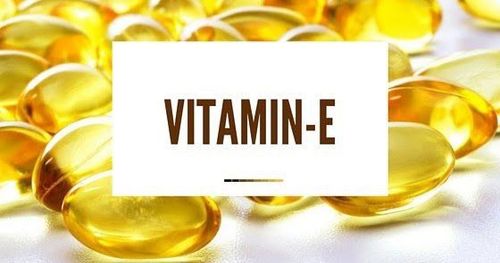This is an automatically translated article.
Vitamin E enters the blood through the chylothorax in the lymph, then is widely distributed into all tissues and accumulates in adipose tissue. As with any drug, unwanted interactions can occur during use.
1. What is Vitamin E?
Vitamin E is an important nutrient for vision, reproduction and the health of the body's blood, brain and skin, and it's also an antioxidant, which can protect your cells against effects of free radicals and generated molecules. If you take vitamin E for its antioxidant properties, keep in mind that supplements may not provide the same benefits found in foods that naturally contain antioxidants.
Sources of vitamin E for the body include:
Foods such as sunflower oil, olives, legumes, almonds.... Meat, milk, green vegetables and fortified cereals; Vitamin E is also available as an oral supplement in capsules or drops. The recommended amount of vitamin E for adults is 15 mg per day.
2. Possible interactions when taking vitamin E
2.1 Cyclosporine (Neoral, Sandimmune) interacts with Vitamin E Taking large amounts of vitamin E along with cyclosporine (Neoral, Sandimmune) might increase the amount of cyclosporine (Neoral, Sandimmune) that the body absorbs. By increasing the amount of cyclosporine the body absorbs, vitamin E may increase the effects and side effects of cyclosporin (Neoral, Sandimmune).
2.2 Drugs that are changed by the liver (Cytochrome P450 3A4 (CYP3A4) substrate) interacts with Vitamin E Vitamin E may increase how quickly the liver breaks down certain medications. Taking vitamin E along with certain medications that are broken down by the liver may decrease their effectiveness. Before taking vitamin E, talk to your doctor if you are taking any medications for liver disease.
2.3 Cancer Drugs (Chemotherapy) Interacts With Vitamin E Vitamin E is an antioxidant, there is some concern that antioxidants may reduce the effectiveness of some cancer medications However, it is currently too early to know if drug interactions will occur.
2.4 Drugs that slow blood clotting (anticoagulants/antiplatelets) interacts with Vitamin E Taking vitamin E with medicines that slow blood clotting may increase the risk of bruising and bleeding. Some medications that slow blood clotting include aspirin, clopidogrel, diclofenac, ibuprofen, naproxen, dalteparin, enoxaparin, heparin, warfarin, and others.
2.5 Drugs used to lower cholesterol (Statins) interacts with vitamin E Taking vitamin E, beta-carotene, vitamin C, and selenium together might decrease the effectiveness of some medications used to lower cholesterol. It is not known if taking vitamin E alone reduces the effectiveness of some medications used to lower cholesterol.
2.6 Niacin interacts with Vitamin E Taking vitamin E along with beta-carotene, vitamin C, and selenium might decrease some of the beneficial effects of niacin. Niacin can increase good cholesterol. When you take a combination of vitamin E with some other vitamins, it also reduces cholesterol significantly.

Trong quá trình sử dụng vitmain E cũng có thể xảy ra các tương tác thuốc không mong muốn
3. What does vitamin E deficiency cause?
Vitamin E deficiency is rare and obvious deficiency symptoms are not found in otherwise healthy individuals. Very low birth weight premature babies (<1,500 grams) may be vitamin E deficient. Supplementing with vitamin E in these babies may reduce the risk of some complications affecting the retina.
The digestive tract needs fat to absorb vitamin E, people with fat malabsorption disorders are more prone to vitamin E deficiency than people without the disorder. Deficiency symptoms include peripheral neuropathy, musculoskeletal disease, retinopathy, and impaired immune response.
Some people with abetalipoproteinemia, a rare genetic disorder that results in malabsorption of dietary fats, require large doses of vitamin E (about 100 mg/kg or 5–10 g/day). Vitamin E deficiency secondary to abetalipoproteinemia causes problems such as poor conduction of nerve impulses, muscle weakness, and retinal degeneration leading to blindness.
Vitamin E ataxia and deficiency (AVED) is another rare genetic disorder in which the liver's alpha-tocopherol-transfer protein is defective or absent. People with AVED are so severely deficient in vitamin E that they experience nerve damage and lose the ability to walk unless they take large doses of vitamin E supplements.
Please dial HOTLINE for more information or register for an appointment HERE. Download MyVinmec app to make appointments faster and to manage your bookings easily.













